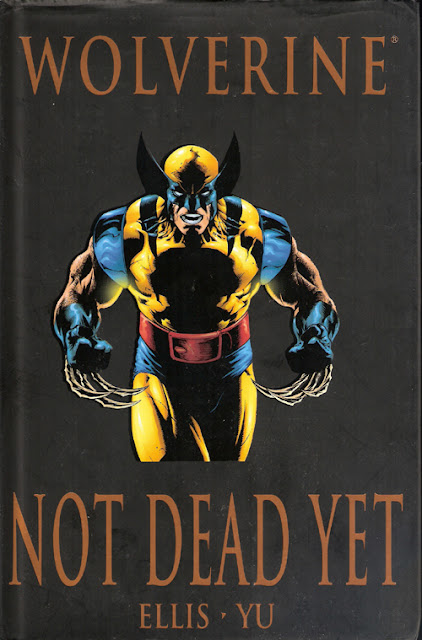The Three Stages of Man: Stage Three: Wolverine First Class, v. 4: Gods, Ninjas, and Divas
Collects: X-Men and Power Pack #1 and Wolverine First Class #13-6 (2005, 2009)
Released: August 2009 (Marvel)
Format: 120 pages / color / $12.99 / ISBN: 9780785135357
What is this?: In this non-continuity book, Wolverine serves as mentor to young Kitty Pryde.
The culprits: Writer Peter David and artists Ronan Cliquet, Scott Koblish, and GuriHiru
Continuing from Stage One and Stage Two, I present:
 Stage Three: The Old Man, represented by Wolverine First Class: Ninjas, Gods, and Divas.
Stage Three: The Old Man, represented by Wolverine First Class: Ninjas, Gods, and Divas.
There comes a point in every man’s life — a sad, soul-battering, inevitable moment — that proves that he is no longer the best at what he does and will most likely never be again. The man must learn to accept his lesser status or else find some other activity in which to find meaning. Youngsters will rise to the top, pushing out the old guard. Age will rob us all of our mental and physical abilities. The symphonies will begin sounding the same as your previous efforts or sound like everyone else’s. Machines will begin adding more and more of that damn technology you don’t understand or don’t want to take the time to futz with. Or changing cultural mores and the whims of corporate masters will change your entire raison d’ etre. As I said, it happens to all of us, if we live long enough.
For Wolverine, he gets to be a mentor to Kitty Pryde. This is a thankless task, as many fans (mostly from the ‘80s) would want a relationship with comic-dom’s mutant sweetheart that is more amorous and less skeevy. Still, someone has to do it, and when you’re no longer the best, you get stuck with such jobs.
Peter David writes these stories as he writes pretty much all his comics, with a humorous bent. This being an ostensibly all-ages title, he doesn’t layer on the angst or darkness, which is a welcome break. And he’s consistently funny, weaving running gags throughout the stories. His humor is gentle and not in the least cutting, with Wolverine giving Kitty the sort of ribbing a father or fond older brother would. It’s pleasant, it’s inoffensive, and it’s funny. What actually happens in this non-continuity book is irrelevant.
The artists are a mixed bag. All of them have trouble making Wolverine look old — and by old, I don’t mean ancient, I mean like he’s in his 30s. All three — Ronan Cliquet (#13-4), Scott Koblish (#15), and GuriHiru (#16 and the Power Pack issue) — make him look like he just dropped out of college. GuriHiru is the worst in this regard, as pretty much every adult looks college age. On the other hand, his Kitty and Siryn are excellent, so it balances out. (Someone should give GuriHiru Studios a title with an all-child or adolescent cast.) Koblish is my favorite of the three, as his work has a definite Art Adams influence that fits the Thor / Ulik fight perfectly. Cliquet gets a lot of action sequences and pulls them off well, but the lone Asian face in the story looks about as Japanese as Angelina Jolie.
Rating:
(4 of 5)
Is there another stage of life that is yet to be revealed through our emissary, Wolverine? That remains to be seen. Wolverine: Enemy of the State would argue the next stage is self-parody, which I believe will have to be integrated into the clinical discussion at some future point in time. It remains to be seen, however.
Labels: 2009 August, 4, Marvel, Shadowcat, Wolverine, Wolverine First Class




 After discovering who he is, it is time for man to be the best he that he can be at what he does, even if it isn’t pretty. If that means composing symphonies and choral works, so be it. If your burden is that you have an outstanding mechanical aptitude, it’s up to you to embrace, not shirk, that destiny. If, like Wolverine, killing a lot of people is what you do, then you need to do it, and do it as often as possible.
After discovering who he is, it is time for man to be the best he that he can be at what he does, even if it isn’t pretty. If that means composing symphonies and choral works, so be it. If your burden is that you have an outstanding mechanical aptitude, it’s up to you to embrace, not shirk, that destiny. If, like Wolverine, killing a lot of people is what you do, then you need to do it, and do it as often as possible.  Stage One: The Enigma, represented by
Stage One: The Enigma, represented by